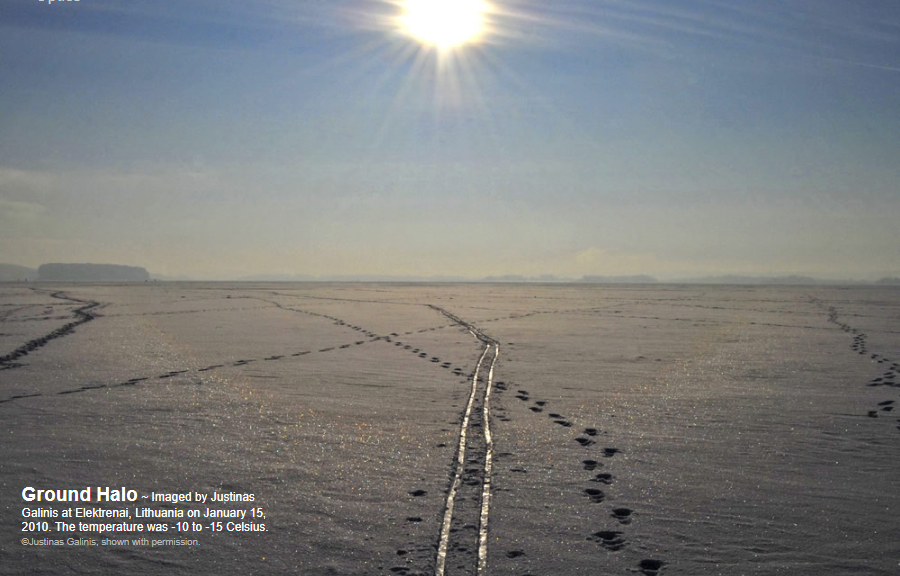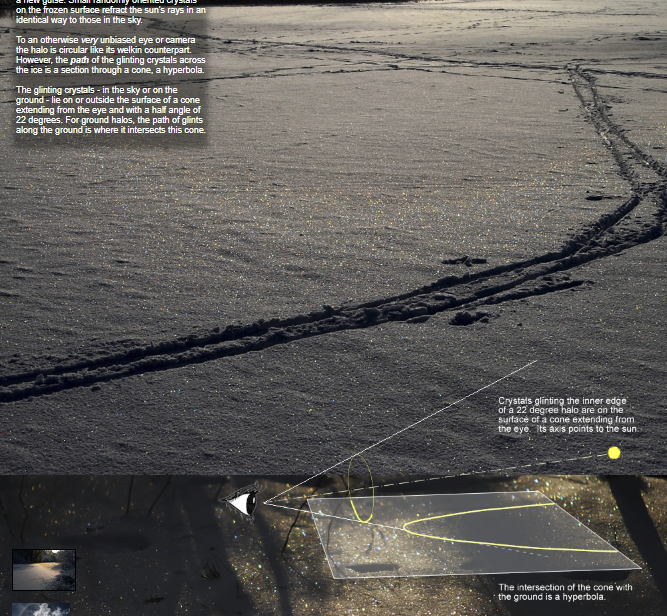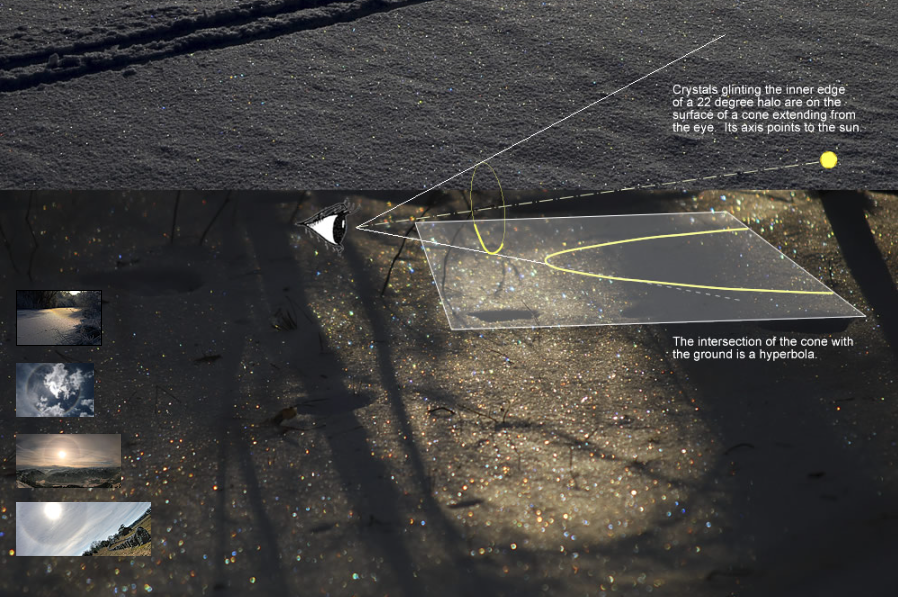Halos on the Ground
Halos on the Ground: A Closer Look at Ground Halos
When we think of halos, we often picture the familiar 22-degree radius halo encircling the sun or moon in the sky. However, there is another intriguing phenomenon known as "ground halos" that occurs when small randomly oriented crystals on the frozen surface refract the sun's rays in a similar way. In this article, we will delve deeper into the fascinating world of ground halos and explore their unique characteristics.
To the naked eye or a camera, a ground halo appears circular, just like its counterpart in the sky. However, upon closer examination, we discover that the path of the glinting crystals across the ice forms a section through a cone, creating a hyperbola. These glinting crystals, whether in the sky or on the ground, lie on or outside the surface of a cone that extends from the eye and has a half angle of 22 degrees. In the case of ground halos, the path of these glints along the ground is where it intersects this cone.
Ground halos can be observed under specific conditions, typically when the temperature is below freezing. When the temperature drops, moisture in the air freezes and forms ice crystals on various surfaces, including the ground. These tiny ice crystals act as miniature prisms, refracting sunlight and creating stunning optical effects.
The most common type of ground halo is the 22-degree radius halo, which resembles a circle with a radius of approximately 22 degrees around the sun or moon. This halo occurs due to the refraction and reflection of sunlight within the ice crystals. As light enters and exits these crystals, it undergoes multiple bending and splitting, resulting in the characteristic halo shape.
In addition to the 22-degree radius halo, ground halos can also exhibit other optical phenomena, such as sun dogs, tangent arcs, and even parhelia (also known as sundogs). These additional features occur when sunlight interacts with specific crystal orientations and atmospheric conditions. Sun dogs, for example, appear as bright spots on either side of the sun, often accompanied by a halo. Tangent arcs, on the other hand, form as curved lines tangent to the 22-degree halo.
One of the intriguing aspects of ground halos is their ability to mimic their sky counterparts. When observing a ground halo, it may be challenging to distinguish it from a halo in the sky without careful examination. This similarity is due to the shared physical principles of light refraction and reflection in both cases. Whether in the sky or on the ground, the behavior of light interacting with ice crystals follows the same rules, resulting in comparable optical phenomena.
Photographing ground halos can be a rewarding experience for photographers and enthusiasts alike. The unique interplay between light, ice crystals, and the surrounding environment creates mesmerizing images that showcase the beauty of atmospheric optics. To capture the best shots of ground halos, it is essential to consider factors such as lighting conditions, crystal orientation, and composition. Experimenting with different angles and settings can lead to stunning photographs that highlight the intricacies of these natural phenomena.
In conclusion, ground halos offer a captivating glimpse into the world of atmospheric optics. These optical phenomena, created by the refraction and reflection of sunlight within ice crystals on the frozen surface, can produce striking visual displays. From the iconic 22-degree radius halo to the intricate sun dogs and tangent arcs, ground halos provide a unique perspective on the interaction between light and ice. By exploring and photographing these enchanting phenomena, we gain a deeper appreciation for the wonders of our atmosphere and its ability to create breathtaking optical effects.

Ground Halo ~ Imaged by Justinas Galinis at Elektrenai, Lithuania on January 15, 2010. The temperature was -10 to -15 Celsius. ©Justinas Galinis, shown with permission.

Here the familiar 22 degree radius halo takes on a new guise. Small randomly oriented crystals on the frozen surface refract the sun's rays in an identical way to those in the sky.
To an otherwise very unbiased eye or camera the halo is circular like its welkin counterpart. However, the path of the glinting crystals across the ice is a section through a cone, a hyperbola.
The glinting crystals - in the sky or on the ground - lie on or outside the surface of a cone extending from the eye and with a half angle of 22 degrees. For ground halos, the path of glints along the ground is where it intersects this cone.

Note: this article has been automatically converted from the old site and may not appear as intended. You can find the original article here.
Reference Atmospheric Optics
If you use any of the definitions, information, or data presented on Atmospheric Optics, please copy the link or reference below to properly credit us as the reference source. Thank you!
-
<a href="https://atoptics.co.uk/blog/halos-on-the-ground/">Halos on the Ground</a>
-
"Halos on the Ground". Atmospheric Optics. Accessed on November 26, 2024. https://atoptics.co.uk/blog/halos-on-the-ground/.
-
"Halos on the Ground". Atmospheric Optics, https://atoptics.co.uk/blog/halos-on-the-ground/. Accessed 26 November, 2024
-
Halos on the Ground. Atmospheric Optics. Retrieved from https://atoptics.co.uk/blog/halos-on-the-ground/.